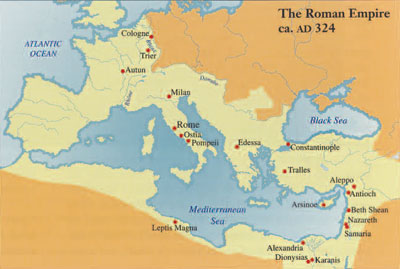 This is the second issue of Expedition Magazine to focus on Roman topics in the space of a year. Like last year’s issue on “Glass in the Roman World” (Vol. 38, No. 2), it is designed in part to accompany the Museum’s up-coming exhibit, Roman Glass: Reflections on Cultural Change. The exhibition, which opens on September 27, 1997, will feature more than 180 glass vessels from our collections.
This is the second issue of Expedition Magazine to focus on Roman topics in the space of a year. Like last year’s issue on “Glass in the Roman World” (Vol. 38, No. 2), it is designed in part to accompany the Museum’s up-coming exhibit, Roman Glass: Reflections on Cultural Change. The exhibition, which opens on September 27, 1997, will feature more than 180 glass vessels from our collections.
The previous Expedition covered the history of the Museum’s collections and the background to the exhibit quite fully. The present issue is more wide-ranging, and includes articles on rather diverse topics, mostly dealing with the later Roman period. A common thread that runs through them, however, is the theme of overlooked and/or underutilized resources—people, artifacts—and the need to reexamine common assumptions in the light of these resources. For example, consulting the 3rd century Marble Plan of Rome, in conjunction with 4th century architectural census tables, allows author David Reynolds to conjure up the now vanished non-monumental architecture of the city. He finds that rich and poor lived side by side in Rome, and that people lived and worked in the same buildings, not in the segregated enclaves that we in our modern American zoned cities are familiar with.
Hugh Elton notes that we tend to be most accustomed to the picture of the Roman army at war, the view from the “sharp end,” as he writes. But here he looks at more neglected aspects of the late Roman army’s dealings with civilians: the extravagant parades and displays, and the widespread corruption and extortion. “There was a price to pay” when the army came to town.
Michael Vickers addresses the common misconception that during the time of the Roman Empire glass was a luxury material and highly sought after. When visiting the Museum’s glass exhibit and marveling at the beauty and grace of the pieces on display, it will be salutary to remember that in antiquity such glass vessels would have been considered inferior to infinitely more valuable pieces made in rock crystal, murrhine, and other hardstones. Vickers traces the change in glass’s status from the lowly place it was accorded in antiquity to its more exalted position now.
John Scarborough returns to this issue of Expedition to give us a synopsis of the career and contributions of an important but overlooked Byzantine physician, Alexander of Trailles. Though arguably the “best physician in the Byzantine Empire,” no English translations exist of Alexander’s Twelve Books and other medical tracts. As Scarborough notes, Alexander combined the “hook-learning” of Galen, Dioscorides, and other Greco-Roman authorities with his own hard-won knowledge of pharmaceuticals to describe the best forms of medicine and medical therapeutics.
Stuart Fleming, acting curator for the Roman Glass exhibit, here finishes the story of glass that he started in the previous Expedition. In that issue he used a number of vessels in the Museum’s Mediterranean and Near East collections to illustrate the initial growth of the Roman glassmaking industry during the 1st and early 2nd centuries AD. Here he presents vignettes of prototypical glass vessels from our collections that date to the late Roman period. Due to space limitations, Fleming has not addressed one important category of glass vessels, namely, tableware. These are, however, covered in the catalogue of the exhibit, which will be published this year by the Museum’s Publication Department under the same title as the exhibition, Roman Glass: Reflections on Cultural Change.
Helen Schenck, Editor
The exhibition on Roman Glass has been made possible by The Susan Helen Horsey Fund of the Philadelphia Foundation; Resource America, Inc., in memory of Francis “Reds” Bagnell The National Endowment For the Am. a federal granting agency; Dr. and Mrs. Gregory Maslow; PECO Energy Company; Mr. and Mrs. A. Bruce Mainwaring; The Pew Charitable Trusts; Mr. and Mrs. Robert Groff, Jr.; Estate of Clive Hulick; Samuel H. Kress Foundation; John J. Medveckis Foundation; George Vaux (deceased); Estate of Conceal Savage; and an in-kind contribution from Tiffany & Co.
